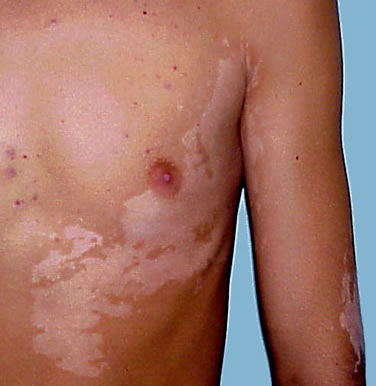Vitiligo
Vitiligo or leukoderma is an
irregular patch of white caused by the loss of melanocytes
or melanin pigment producing cells.

Vitiligo or leukoderma patches.
In a similar condition called chemical leukoderma,
phenol chemicals commonly found in industrial cleansers and solvents
cause depigmented when applied to the skin.
How is it Pronounced?
Veet-tel-I-go (rhymes with "little-I-go").
The word vitiligo is derived from the Latin vitimeaning
"blemish" and ligo meaning "to cause".
Symptoms of Vitiligo
The symptoms of vitiligo are:
- Irregularly shaped white patches
- Body hair turning white in the areas
- One or many patches on the body
Although it can occur on any part of the body, vitiligo most
often occurs on:
- Face
- Neck
- Arms
- Hands
- Underarms
- Feet
- Genitals
This condition is progressive - the patches usually becomes larger
in size and more numerous. They may gradually spread to other
parts of the body.
Causes of Vitiligo?
The exact cause is not known. It is thought, however, it is a
form of autoimmune disorder, where the body's immune system mistakenly
recognize the melanocytes as foreign cells and destroy them.
Vitiligo is thought to be triggered and made worse by:
Who Gets It?
It is thought that this skin condition is a genetic or inherited
condition. Although most people with vitiligo are perfectly healthy,
they often have higher risk of developing:
- Thyroid disease
- Anemia
- Diabetes
Is it Contagious?
No, vitiligo is not contagious.
Treatment of Vitiligo
Self-treatment for vitiligo is limited to:
- Using cosmetics to "cover and hide" the white patches
- Avoiding suntanning on normal skin
Remember that the white areas do not have any pigments and therefore
are particularly prone to sunburn and sun-damage. Use lotion
with high SPF (sun protection factor) of 30 or higher.
Medical treatments for vitiligo are:
- Psoralen photochemotherapy
This is a light therapy using ultraviolet A (UVA)
combined with psoralen - a medication that
causes the skin to become more sensitive to UVA. This procedure
is done at your doctor's office several times a week for many
months.
- Steroid cream
When caught early, steroid creams may bring color and pigment
back to the area after about 6 months.
- Depigmentation
In people with more depigmented areas than normal, a chemical
depigmentation process be done to achieve a more uniform skin
color.
Here, monobenzylether hydroquinone chemical is used to permanently
remove pigment from normal areas of the skin.
Note that the treatments above often have low and varied success
rate.


